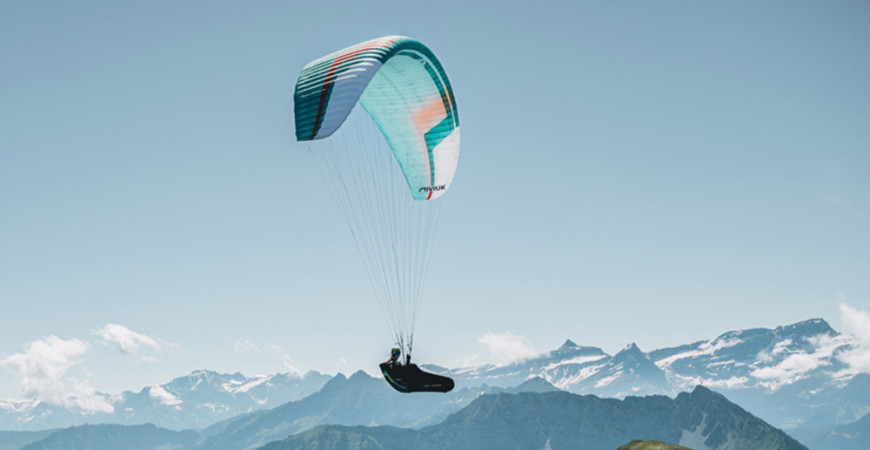Test of the Niviuk Hiko paraglider
For this test, I chose the Hiko in size 22 m² with an all-up weight of 83 kg. The test took place at the Saint Hilaire du Touvet site: training slope for the first inflations, followed by a few flights in calm conditions, then thermal flights to assess the behavior in the air.
The goal was to verify whether this intermediate wing (EN B) lives up to its promises in terms of passive safety, handling, and flying pleasure for a pilot wishing to progress or fly recreationally.
Reception of the wing, unboxing, delivered accessories
Upon receiving the Hiko paraglider wing, the packaging meets Niviuk’s standards: the wing is delivered in a Kargo series carrying bag from Niviuk, with a compression strap, a standard compression bag, a small repair kit, and the certification label along with the user manual. The finish is impeccable: the lower surface rods are well cut, and there is nothing to report regarding the overall build quality of the wing.
During the preflight check, the opening is smooth: the cells are regular, the line layout is clear and intuitive, and there are no major tangles or knots during preparation. The carrying bag has an adequate volume and is easy to compress — a practical detail for fitting it into the back of the harness. The modern colors and the design adopted by Niviuk across its new range of wings this year are also very appealing.
One point to note: although the wing is a B-Mod category, the first impression upon delivery is that of a “ready-to-fly” piece of equipment — reliable, well-balanced, and confidence-inspiring before takeoff.
Technical characteristics of the wing
The Hiko paraglider wing is EN B certified. With its 5.5 flat aspect ratio, Niviuk aimed to find the right balance for intermediate pilots seeking a modest level of performance combined with passive safety. Based on the test report conducted by Air Turquoise, it is clear that the wing was designed to achieve this equilibrium.
The weight ranges overlap by 10 kilograms from one size to the next, allowing most pilots to find a size that perfectly matches their total flying weight.
According to the technical sheet, the Hiko size 22 weighs approximately 3.14 kg in the light “P” version and 4.23 kg in the standard version — both in line with the weight standards for its category. For this test, I used the standard version, and measured around 4.2 kg on the scale.
With its 55 cells, Niviuk has developed a stable and comfortable profile that still delivers solid performance in flight.
Inflation and takeoff of the wing
At the Saint-Hilaire-du-Touvet site, I performed several inflations in various conditions — on a gentle slope, with short grass, in light and then moderate wind:
In light wind
The Hiko inflates very cleanly. The rise is smooth and consistent, without any surge. The wing climbs overhead without the need for heavy braking during the hold phase. The feeling in the brakes confirms good internal pressure, efficient air intake, and the ease of profile inflation. With an all-up weight of 83 kg, the wing remains agile, and just a small step is enough for takeoff — which is very reassuring.
In moderate wind
As the wind increases, the Hiko wing from Niviuk remains very manageable. The lift during inflation is well contained, allowing good control without significant effort.
The wing remains forgiving: it tolerates slightly late brake inputs or small imbalances, making it ideal for all types of takeoffs in moderately windy conditions.
Takeoff
With this wing, takeoff happens in just two or three steps, with a progressive yet fairly quick and reassuring lift-off.
The synchronization between the pilot’s speed and the Hiko’s inflation speed feels very intuitive, and even with a slight mismatch, the takeoff remains smooth, comfortable, and pleasant.
The NIVIUK Hiko paraglider wing in flight
General feeling in flight
As soon as you take off, the Hiko sets a pleasant tone: the wing is stable and provides just the right amount of feedback without being excessive — perfectly suited for an intermediate paraglider wing. The handling is smooth, and transitional phases are easy to manage. Any pilot with a bit of experience will feel confident flying under this wing.
Thermals & handling
In the light to moderate thermal conditions of Saint-Hilaire, the Hiko proved to be efficient. The handling is precise: the wing turns well and responds to brake inputs with moderate but sufficient travel. It’s easy to tighten the turn without the wing dropping into a negative or surging forward. Turns are effortless, and maintaining the turn radius is simple, allowing efficient work within thermals.
Performance, speedbar and glide
In terms of glide performance, it doesn’t compete with high-performance wings, but within its category, it performs very honorably. Niviuk doesn’t emphasize extreme numbers, instead focusing on a good balance between safety and performance. When using the speedbar, the wing responds evenly — speed increases smoothly without any loss of stability.
For a pilot within this weight range, the wing doesn’t “slow down”; it retains good energy and never feels like it’s reaching its limits — a very positive sign.
Passive safety and critical behaviour
During more “committed” maneuvers, the Hiko shows good stability. Partial collapses reopen naturally, the stall is progressive and easy to manage. The profile provides solid pitch stability, which inspires confidence.
This behavior aligns perfectly with Niviuk’s positioning of the Hiko.

Packing, transport, versatility
Even though it’s not an ultra-light wing (that role being reserved for its smaller sister, the Hiko P), the Hiko remains quite compact and easy to carry. For a leisure pilot or occasional hike-and-fly use, it’s a very good compromise. The packed volume is reasonable.
Landing, versatility and recommended use
Landing
The landing phase was just as satisfying: the Hiko rounds out nicely, and the wing’s glide allows for an effective flare while touching down gently. Even in slightly turbulent conditions or with a wind gradient, you can land with confidence.
Versatility and recommended uses
In terms of use, here’s what I observed:
- An excellent choice for a pilot already familiar with EN B wings who wants to progress or gain performance without moving up to a higher category.
- Perfect for regular leisure flying: mountain sites, cross-country — you’ll easily achieve your first 200 km flights in the Alps if you have the skill.
- For hike & fly pilots: if you really want to optimize transport, the “P” version is available, but the standard version offers better robustness and versatility.
- For pilots with moderate experience who want to try competition flying, the Hiko will accompany you through your first tasks with ease!
Recommendation for this size (22) and this weight range (~85 kg)
With an all-up weight around 83 kg, the size 22 is well suited: you’re in the upper part of the weight range, which adds a bit more dynamism while maintaining stability. For frequent flights in calm conditions, it performs very well. If your goal is to fly in stronger conditions or aim for maximum performance, a more “performance-oriented” model could be considered. But for the vast majority of mountain and recreational flights, this setup seems perfectly appropriate.
Summary & overall impression
After several sessions at the Saint-Hilaire-du-Touvet site, I’ve drawn the following conclusions:
Strengths
• Very easy inflation and takeoff: reassuring for progression.
• Stable, responsive, and sufficiently informative in flight: you can feel the air without being constantly shaken.
• Good versatility: suitable for both local flights and cross-country.
• High-quality construction and finish: inspires immediate confidence.
Points to consider
If you consistently fly in strong conditions or like to “push” your performance, you may start to feel a limit. A wing like the Ikuma would better meet a pilot’s desire for higher performance in such situations.
Verdict
I consider the Niviuk Hiko to be an excellent companion for the intermediate leisure pilot who wants to progress with confidence, enjoy beautiful and peaceful flights, and have a reliable wing that will last over time.
It perfectly meets its target: combining safety, enjoyment, and agility without sacrificing the desire to explore a little further.
Conclusion
In conclusion, the Hiko at Saint-Hilaire-du-Touvet proved to live up to its ambitions: a serious intermediate wing, uncompromising on safety, that allows you to fly with pleasure in a wide range of conditions.
If you are a pilot in the progression, leisure, or freedom category, this wing deserves your attention. It offers an excellent balance between accessibility, reliability, and enjoyment.








